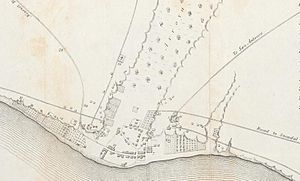Battle of La Paz
| Battle of La Paz | |||||||
|---|---|---|---|---|---|---|---|
| Part of the Pacific Coast Campaign | |||||||
 La Paz disposition of forces in 1847 | |||||||
| |||||||
| Belligerents | |||||||
|
|
| ||||||
| Commanders and leaders | |||||||
|
Henry S. Burton |
| ||||||
| Strength | |||||||
| 115 infantry[1]: 27 | 200 militia[1]: 38 | ||||||
| Casualties and losses | |||||||
| 1 killed[2]: 164 | 6 killed[2]: 163 | ||||||
The Battle of La Paz was an engagement of the
officers. The battle occurred on November 16 and 17, 1847.Background
In late September,
Their mission was to reinforce the
On 21 July, 115 men from the Seventh Regiment of New York Volunteers landed peacefully at La Paz.[1]: 27 Lieutenant E. Gould Buffum, of Company B, later described the port city: "The houses were all of adobe, plastered white, and thatched with the leaves of the palm tree, and were most delightfully cool. The whole beach was lined with palms, date, fig, tamarind and coconut trees, their delicious fruit hanging down on them in clusters."[1]: 28
Following the
Before departing to capture
Burton's La Paz garrison occupied two houses on the plain commanding the town, on the south side of The
Battle
At 2 AM
On the morning of 17 Nov., Burton's spherical case shot drove some Mexicans from another house, after which he destroyed the houses on the north side of The Arroyo, strengthened his breastworks, and the roofs of the houses he occupied.[2]: 164
Aftermath
Pineda's men withdrew but continued to hover about the garrison,[2]: 164 eventually resulting in the Siege of La Paz.
References
- ^ ISBN 978-0870932397
- ^ ISBN 978-0870932397
Further reading
- Nathan Covington Brooks, A Complete History of the Mexican War (The Rio Grande Press, Inc., 1965).
- Justin H. Smith, The War With Mexico, Vols. I and II. (Peter Smith, Gloucester, Mass., 1963).
- John R. Spears, The History of the Navy, Vol. III (Charles Scribner's Sons, New York, 1897), pp. 401–409.
- K. Jack Bauer, Surfboats and Horse Marines (U.S. Naval Institute, Annapolis, Md., 1969).
- President James K. Polk's Message on War with Mexico, May 11, 1846, in Documents of American History, 9th edition, Vol. I (Prentice Hall, Inc., 1979), p. 311.
